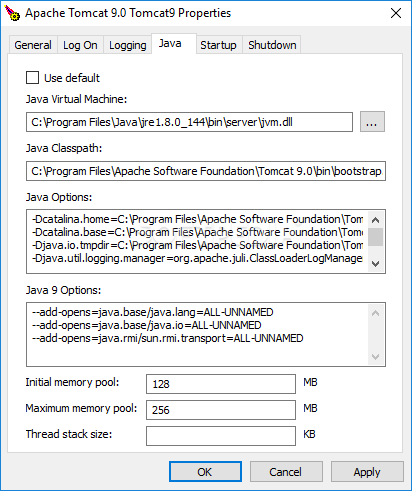
ErrorDispatcher.javacError(ErrorDispatcher.java:331) DefaultErrorHandler.javacError(DefaultErrorHandler.java:102) It is indirectly referenced from required. : Unable to compile class for JSP:Īn error occurred at line: 1 in the generated java file HTTP Status 500 - Unable to compile class for JSP:ĭescription The server encountered an internal error that prevented it from fulfilling this request. Jun 06 02:35:06 usercore systemd: rvice failed.Īfter Installing Tomcat 7, while running it I am reciveing a following page. Jun 06 02:35:06 usercore systemd: Unit rvice entered failed state. Jun 06 02:35:06 usercore systemd: rvice: main process exited, code=exited, status=1/FAILURE Jun 06 02:35:06 usercore server: at (ClassLoader.java:357) Jun 06 02:35:06 usercore server: at $AppClassLoader.loadClass(Launcher.java:331) Jun 06 02:35:06 usercore server: at (ClassLoader.java:424) Jun 06 02:35:06 usercore server: at (URLClassLoader.java:381) Jun 06 02:35:06 usercore server: Caused by: : .LogFactory

Jun 06 02:35:06 usercore server: at .Bootstrap.(Bootstrap.java:49) Jun 06 02:35:06 usercore server: Exception in thread "main" : org/apache/juli/logging/LogFactory Main PID: 13299 (code=exited, status=1/FAILURE) Process: 13299 ExecStart=/usr/libexec/tomcat/server start (code=exited, status=1/FAILURE) Loaded: loaded (/usr/lib/systemd/system/rvice enabled vendor preset: disabled)Īctive: failed (Result: exit-code) since Thu 02:35:06 +07 6s ago You may want to delete all the comments between the following lines, or you may leave them if you want to reference the examples:Īfter Installing Tomcat 7, and start tomcat service, it failed with message: rvice - Apache Tomcat Web Application Container
#Apache tomcat 7.0 52 how to
This file is filled with comments which describe how to configure the file. sudo vi /usr/share/tomcat/conf/tomcat-users.xml.We will do this by editing the tomcat-users.xml file: In order to use the manager webapp installed in the previous step, we must add a login to our Tomcat server. Configure Tomcat Web Management Interface
#Apache tomcat 7.0 52 install
sudo yum install tomcat-docs-webapp tomcat-javadocĪnswer y at the prompt to install the documentation packages.If you want to install the Tomcat documentation, so that all of the links on the default Tomcat page will work, run this command: This adds the ROOT, examples, sample, manager, and host-manager web apps to the tomcat/webapps directory. sudo yum install tomcat-webapps tomcat-admin-webapps.To install the default Tomcat root page (tomcat-webapps), and the Tomcat Web Application Manager and Virtual Host Manager (tomcat-admin-webapps), run this command: Luckily, there are packages that include these tools as web applications. If you are just getting started with Apache Tomcat, you will most likely want to install some admin tools that will help you deploy your Java applications and manage your virtual hosts. Note that the Tomcat service will not be running yet.


etc/default/tomcat7 - JAVA_OPTS JAVA_OPTS="=file:/dev/./urandom =true -Xmx 512m -XX:MaxPermSize= 256m -XX:+UseConcMarkSweepGC"
#Apache tomcat 7.0 52 free
Feel free to change the Xmx and MaxPermSize values-these settings affect how much memory Tomcat will use: sudo vi /usr/share/tomcat/conf/nfĪdd the following JAVA_OPTS line to the file.Let’s make a quick change to the Java options that Tomcat uses when it starts. In this tutorial, however, we will install a few additional packages that will help you manage your Tomcat applications and virtual hosts. If you already have a Tomcat application that you want to run, you can place it in the /usr/share/tomcat/webapps directory, configure Tomcat, and restart the Tomcat service. Most of the important Tomcat files will be located in /usr/share/tomcat. This will install Tomcat 7 and its dependencies, such as Java, and it will also create the tomcat user. Run the following command to install the Tomcat package:Īnswer y at the confirmation prompt to install tomcat. We will be using the demo user for the rest of this tutorial. You can learn how to do this by completing the initial server setup for CentOS 7 tutorial. Prerequisitesīefore you begin with this guide, you should have a separate, non-root user account set up on your server. Check out this tutorial to learn more about Droplet User Data. Note: Tomcat can be installed automatically on your Droplet by adding this script to its User Data when launching it.


 0 kommentar(er)
0 kommentar(er)
